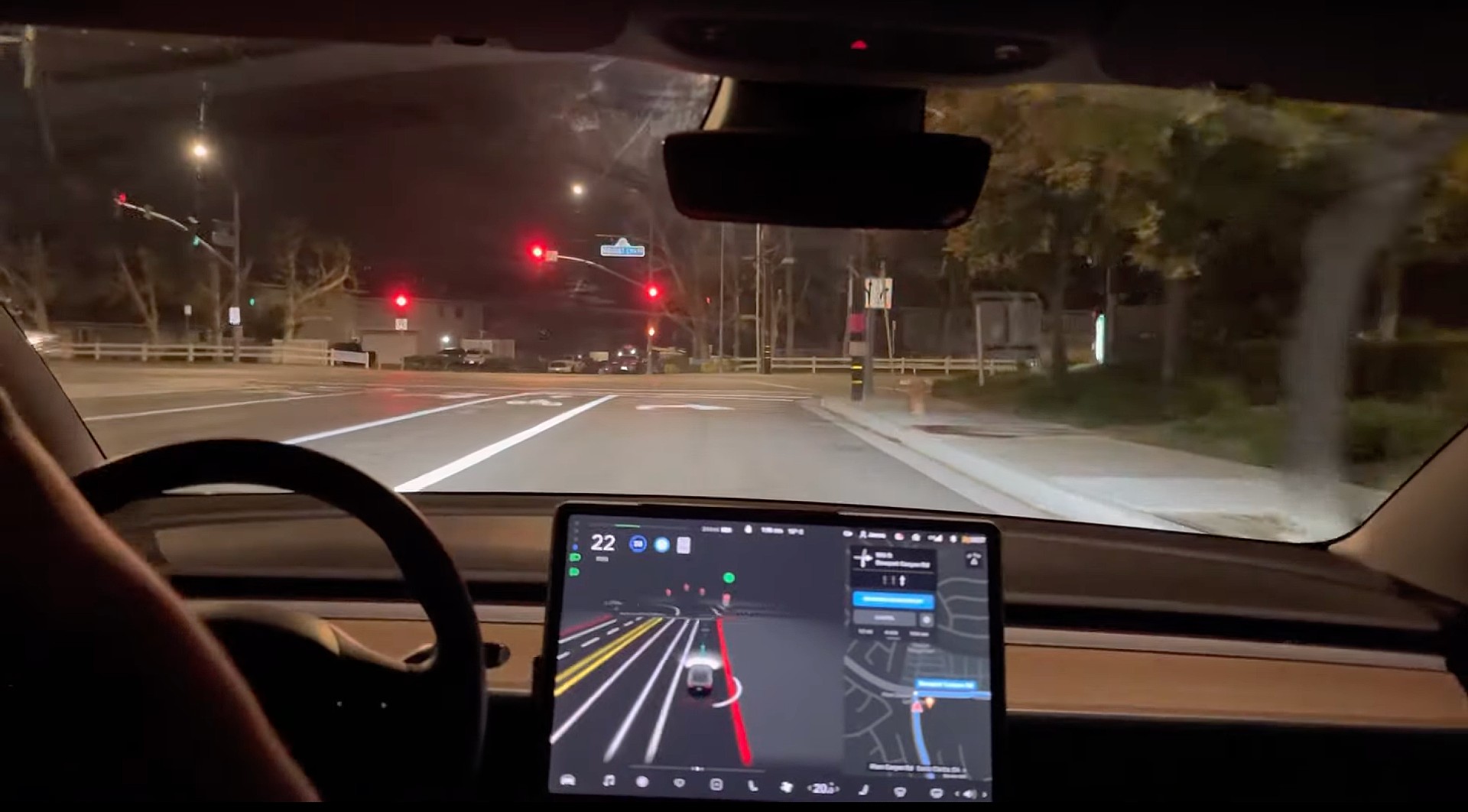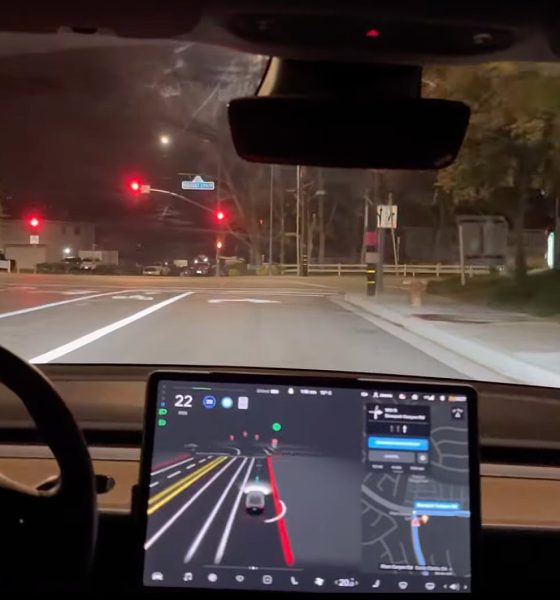

News
Tesla formally starts FSD Beta 10.3 rollout, includes drivers with 99 Safety Score
Tesla has formally started the rollout of FSD Beta 10.3 to its fleet. The latest iteration of the advanced driver assist system featured several improvements that were outlined in some detailed Release Notes.
As observed by members of the electric vehicle community, FSD Beta 10.3 is now being rolled out to drivers with a Safety Score of 99 and above. This was previously mentioned by CEO Elon Musk on Twitter, who noted that the advanced driver assist system would gradually be released to owners with Safety Scores below 100.
The following are the detailed Release Notes for Tesla FSD Beta 10.3.
- Added FSD Profiles that allow drivers to control behaviors like rolling stops, exiting passing lanes, speed-based lane changes, following distance and yellow light headway.
- Added planning capability to drive along oncoming lanes to maneuver around path blockage.
- Improved creeping speed by linking speed to visibility network estimation and distance to encroachment point of crossing lanes.
- Improved crossing object velocity estimation by 20% and yaw estimation by 25% by upreving surround video vehicle network with more data. Also increased system frame rate by +1.7 frames per second.
- Improved vehicle semantic detections (e.g. brake lights, turn indicators, hazards) by adding +25k video clips to the training data set.
- Improved static obstacle control by upreving the generalized static object network with 6k more video clips (+5.6% precision, +2.5% recall).
- Allowed more acceleration when merging from on-ramps onto major roads and when lane changing from slow to fast lanes.
- Reduced false slowdowns and improved offsetting for pedestrians by improving the model of interaction between pedestrians and the static world.
- Improved turning profile for unprotected turns by allowing ego to lane lines more naturally, when safe to do so.
- Improved speed profile for boosting onto high-speed roads by enforcing stricter longitudinal and lateral acceleration limits required to beat the crossing objects.
The release of FSD Beta 10.3 was initially set for Friday midnight. As Saturday rolled in, however, members of the FSD Beta group observed that no such updates were being received by their vehicles. Elon Musk eventually explained the slight delay, noting that Tesla had found some “regression in some left turns at traffic lights” was found by the company’s internal QA team. With a fix being developed for the observed behavior, Musk noted that FSD Beta 10.3 would likely be rolling out on Sunday instead. This estimate proved accurate.
Considering that Tesla is adopting a conservative approach to the rollout of FSD Beta, it would not be surprising if the company enforces even stricter rules for inattentive drivers or users who are using the advanced driver assist system irresponsibly. Just a few days ago, and as a copy of a message from Tesla issuing a warning to an FSD Beta tester made the rounds online, Elon Musk confirmed that the company is indeed kicking out users who are misusing the system by being inattentive to the road.
Tesla is currently experiencing some scrutiny from the NHTSA, with the agency probing the company over incidents where a vehicle in Autopilot crashed into a stationary emergency vehicle. Tesla has since rolled out a safety update for Autopilot, which, in turn, seemingly aggravated the NHTSA since the company did not issue a recall before releasing its over-the-air software update. During the Q3 2021 earnings call, however, Tesla executives highlighted that the company welcomes the scrutiny, and that the it is willing to work with any safety agency to make its the roads as safe as possible.
Watch Tesla FSD Beta 10.3 in action in the video below.
The Teslarati team would appreciate hearing from you. If you have any tips, reach out to me at maria@teslarati.com or via Twitter @Writer_01001101.

News
Tesla starts showing how FSD will change lives in Europe
Local officials tested the system on narrow country roads and were impressed by FSD’s smooth, human-like driving, with some calling the service a game-changer for everyday life in areas that are far from urban centers.

Tesla has launched Europe’s first public shuttle service using Full Self-Driving (Supervised) in the rural Eifelkreis Bitburg-Prüm region of Germany, demonstrating how the technology can restore independence and mobility for people who struggle with limited transport options.
Local officials tested the system on narrow country roads and were impressed by FSD’s smooth, human-like driving, with some calling the service a game-changer for everyday life in areas that are far from urban centers.
Officials see real impact on rural residents
Arzfeld Mayor Johannes Kuhl and District Administrator Andreas Kruppert personally tested the Tesla shuttle service. This allowed them to see just how well FSD navigated winding lanes and rural roads confidently. Kruppert said, “Autonomous driving sounds like science fiction to many, but we simply see here that it works totally well in rural regions too.” Kuhl, for his part, also noted that FSD “feels like a very experienced driver.”
The pilot complements the area’s “Citizen Bus” program, which provides on-demand rides for elderly residents who can no longer drive themselves. Tesla Europe shared a video of a demonstration of the service, highlighting how FSD gives people their freedom back, even in places where public transport is not as prevalent.
What the Ministry for Economic Affairs and Transport says
Rhineland-Palatinate’s Minister Daniela Schmitt supported the project, praising the collaboration that made this “first of its kind in Europe” possible. As per the ministry, the rural rollout for the service shows FSD’s potential beyond major cities, and it delivers tangible benefits like grocery runs, doctor visits, and social connections for isolated residents.
“Reliable and flexible mobility is especially vital in rural areas. With the launch of a shuttle service using self-driving vehicles (FSD supervised) by Tesla in the Eifelkreis Bitburg-Prüm, an innovative pilot project is now getting underway that complements local community bus services. It is the first project of its kind in Europe.
“The result is a real gain for rural mobility: greater accessibility, more flexibility and tangible benefits for everyday life. A strong signal for innovation, cooperation and future-oriented mobility beyond urban centers,” the ministry wrote in a LinkedIn post.
News
Tesla China quietly posts Robotaxi-related job listing
Tesla China is currently seeking a Low Voltage Electrical Engineer to work on circuit board design for the company’s autonomous vehicles.

Tesla has posted a new job listing in Shanghai explicitly tied to its Robotaxi program, fueling speculation that the company is preparing to launch its dedicated autonomous ride-hailing service in China.
As noted in the listing, Tesla China is currently seeking a Low Voltage Electrical Engineer to work on circuit board design for the company’s autonomous vehicles.
Robotaxi-specific role
The listing, which was shared on social media platform X by industry watcher @tslaming, suggested that Tesla China is looking to fill the role urgently. The job listing itself specifically mentions that the person hired for the role will be working on the Low Voltage Hardware team, which would design the circuit boards that would serve as the nervous system of the Robotaxi.
Key tasks for the role, as indicated in the job listing, include collaboration with PCB layout, firmware, mechanical, program management, and validation teams, among other responsibilities. The role is based in Shanghai.
China Robotaxi launch
China represents a massive potential market for robotaxis, with its dense urban centers and supportive policies in select cities. Tesla has limited permission to roll out FSD in the country, though despite this, its vehicles have been hailed as among the best in the market when it comes to autonomous features. So far, at least, it appears that China supports Tesla’s FSD and Robotaxi rollout.
This was hinted at in November, when Tesla brought the Cybercab to the 8th China International Import Expo (CIIE) in Shanghai, marking the first time that the autonomous two-seater was brought to the Asia-Pacific region. The vehicle, despite not having a release date in China, received a significant amount of interest among the event’s attendees.
Elon Musk
Elon Musk and Tesla AI Director share insights after empty driver seat Robotaxi rides
The executives’ unoccupied tests hint at the rapid progress of Tesla’s unsupervised Robotaxi efforts.

Tesla CEO Elon Musk and AI Director Ashok Elluswamy celebrated Christmas Eve by sharing personal experiences with Robotaxi vehicles that had no safety monitor or occupant in the driver’s seat. Musk described the system’s “perfect driving” around Austin, while Elluswamy posted video from the back seat, calling it “an amazing experience.”
The executives’ unoccupied tests hint at the rapid progress of Tesla’s unsupervised Robotaxi efforts.
Elon and Ashok’s firsthand Robotaxi insights
Prior to Musk and the Tesla AI Director’s posts, sightings of unmanned Teslas navigating public roads were widely shared on social media. One such vehicle was spotted in Austin, Texas, which Elon Musk acknowleged by stating that “Testing is underway with no occupants in the car.”
Based on his Christmas Eve post, Musk seemed to have tested an unmanned Tesla himself. “A Tesla with no safety monitor in the car and me sitting in the passenger seat took me all around Austin on Sunday with perfect driving,” Musk wrote in his post.
Elluswamy responded with a 2-minute video showing himself in the rear of an unmanned Tesla. The video featured the vehicle’s empty front seats, as well as its smooth handling through real-world traffic. He captioned his video with the words, “It’s an amazing experience!”
Towards Unsupervised operations
During an xAI Hackathon earlier this month, Elon Musk mentioned that Tesla owed be removing Safety Monitors from its Robotaxis in Austin in just three weeks. “Unsupervised is pretty much solved at this point. So there will be Tesla Robotaxis operating in Austin with no one in them. Not even anyone in the passenger seat in about three weeks,” he said. Musk echoed similar estimates at the 2025 Annual Shareholder Meeting and the Q3 2025 earnings call.
Considering the insights that were posted Musk and Elluswamy, it does appear that Tesla is working hard towards operating its Robotaxis with no safety monitors. This is quite impressive considering that the service was launched just earlier this year.








